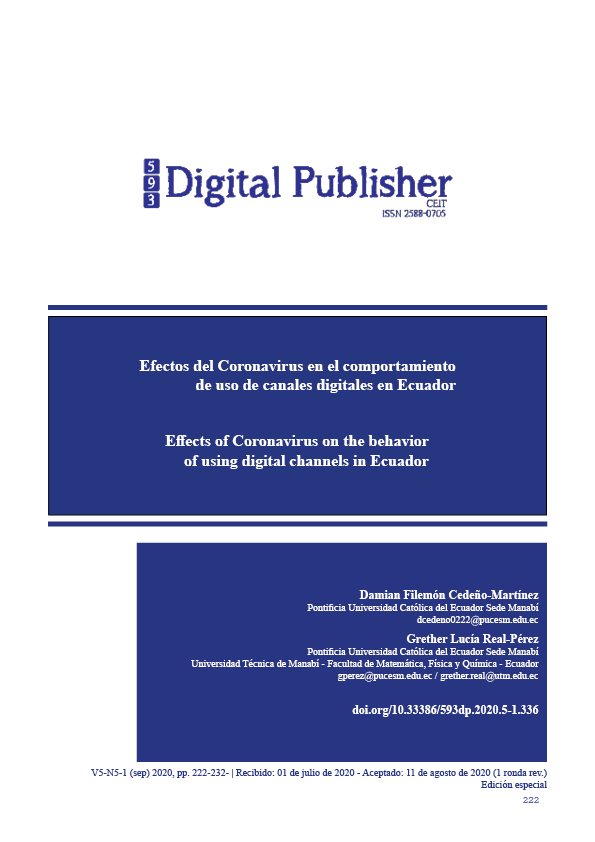Effects of Coronavirus on the behavior of using digital channels in Ecuador
Main Article Content
Abstract
This study reviews the measures adopted to prevent the spread of covid-19, control its expansion and forestall the collapse of health care systems, highlighting how these measures have generated a change in the behavior of Ecuadorian customers, towards the use of digital media. Through bi-biographical review it was possible to define how improved access to digital media and a new consumer behavior due to the pandemic, has generated growth in the use of digital channels compared to traditional business channels transactional. Faced with the pandemic reality and the analysis of the effects it generates, the countries of Latin America and the Caribbean have taken rapid and important measures to respond in the initial stage of the crisis by adopting economic policies to mitigate its effects, which has motivated the preference of the use of digital media, Following this global trend in Ecuador the number of users who make online transactions has multiplied, The COVID-19 has substantially transformed the reality of e-commerce at a global level so that the Accelerating the rate of adoption of non-face-to-face purchases is a propitious context in the midst of the crisis to stimulate the economic sectors and allow companies to innovate and reinvent themselves in this new environment.
Downloads
Article Details
1. Derechos de autor
Las obras que se publican en 593 Digital Publisher CEIT están sujetas a los siguientes términos:
1.1. 593 Digital Publisher CEIT, conserva los derechos patrimoniales (copyright) de las obras publicadas, favorece y permite la reutilización de las mismas bajo la licencia Licencia Creative Commons 4.0 de Reconocimiento-NoComercial-CompartirIgual 4.0, por lo cual se pueden copiar, usar, difundir, transmitir y exponer públicamente, siempre que:
1.1.a. Se cite la autoría y fuente original de su publicación (revista, editorial, URL).
1.1.b. No se usen para fines comerciales u onerosos.
1.1.c. Se mencione la existencia y especificaciones de esta licencia de uso.
References
CAF, C. A. de F. (2020). El estado de la digitalización de América Latina frente a la pandemia del COVID-19. Banco de Desarrollo de América Latina - Corporación Andina de Fomento (CAF), 1–40. https://scioteca.caf.com/handle/123456789/1540
Camara Ecuatoriana de Comercio Electrónico. (2020). ecommerce Iii medición 2020.
CEPAL. (2020a). Informe sobre el impacto económico en América Latina y el Caribe de la enfermedad por coronavirus (COVID-19). Publicaciones CEPAL, 38. https://repositorio.cepal.org/bitstream/handle/11362/45602/1/S2000313_es.pdf
CEPAL. (2020b). Panorama Fiscal de América Latina y el Caribe Gracias por su interés en esta publicación de la CEPAL. https://repositorio.cepal.org/bitstream/handle/11362/43405/7/S1800082_es.pdf
Decreto Ejecutivo No. 1017 Presidencia de la República del Ecuador. (2020). Decreto Ejecutivo No. 1017 Estado de Excepción en todo el territorio nacional (p. 18). https://minka.presidencia.gob.ec/portal/usuarios_externos.jsf
Del Alcázar Ponce, J. P. (2019). Ecuador Estado Digital Ene/19. Mentinno, 37. https://drive.google.com/file/d/116eZRcn-FH-cLVWmGGlt3jAn_SdG1aTL/view
Dezerega y Holguin, E. de K. W. (2020). E-commerce: el big player del confinamiento en Ecuador. Datta Business Innovation. https://datta.com.ec/articulo/e-commerce-el-big-player-del-confinamiento-en-ecuador
Felipe Barrera Páez Nathaly Pinzón Rubio FACULTAD, D. DE, & Administración De Empresas Bogotá Dc, C. DE. (2018). Identificación del cambio en las empresas bancarias colombianas con base en los avances tecnológicos. 1–35. https://repository.javeriana.edu.co/bitstream/handle/10554/39510/Identificación del cambio en las empresas bancarias colombianas con base en los avances tecnológicos.pdf?sequence=1&isAllowed=y
Houtman, I., Jettinghoff, K., & Cedillo, L. (2008). Sensibilizando sobre el estrés laboral en los países en desarrollo. Un riesgo moderno en un ambiente de trabajo tradicional. Consejos para empleadores y representantes de los trabajadores. World Health Organization, 6, 1–41.
OMS. (2020). Declaración de la OMS tras superarse los 100 000 casos de COVID-19. OMS. https://www.who.int/es/news-room/detail/07-03-2020-who-statement-on-cases-of-covid-19-surpassing-100-000
Organización Panamericana de la Salud. (2020). La OMS caracteriza a COVID-19 como una pandemia. 11 De Marzo De 2020.
statista. (2018). statistic_id728993_ecuador_-number-of-internet-subscriptions-2010-2020.pdf.
statista. (2020a). statistic_id1105495_coronavirus-global-online-traffic-impact-as-of-june-2020.pdf. file:///C:/Users/Usuario/Downloads/statistic_id1105495_coronavirus-global-online-traffic-impact-as-of-june-2020.pdf
statista. (2020b). statistic_id1116294_latin-america_-increase-in-web-traffic-during-the-novel-coronavirus-outbreak-2020.pdf. https://www.statista.com/statistics/1116294/increase-web-traffic-latin-america/
Toledo, A. S., & Armas, N. (2020). TIPS de marketing en épocas de COVID y Post COVID. CienciAmérica, 9(2), 99. https://doi.org/10.33210/ca.v9i2.300
WorldBank. (2020). Global Economic Prospects: In The Financial Crisis and the Global South (Issue June). https://doi.org/10.2307/j.ctt183pb3w.5



